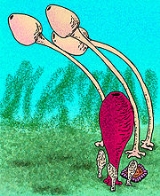
Siphonia
Encyclopedia
Siphonia was a genus
of extinct
hallirhoid
demosponges
of the Upper Cretaceous
. They lived in the Western Tethys Ocean
, in what is now Europe
. They all had distinctive pear-shaped bodies that were attached to the seafloor via a long stem. Their common name, "tulip sponges," refers to their suggestive shape, while the genus name refers to how the spongocoel (the main tube of the sponge body) runs almost the entire length of the sponge, as though it were almost a drinking straw. The length was around half an inch (1 centimeter).
Reconstruction of S. tulipa http://www.deviantart.com/deviation/34455414/
Reconstruction of S. tulipa, S. pyriformis, and the related Hallirhoa costata http://www.deviantart.com/deviation/36886143/
Fossil S. pyriformis http://perso.orange.fr/jean-ours.filippi/anglais/ressourcesangl/anressources/2006/june26.html
Genus
In biology, a genus is a low-level taxonomic rank used in the biological classification of living and fossil organisms, which is an example of definition by genus and differentia...
of extinct
Extinction
In biology and ecology, extinction is the end of an organism or of a group of organisms , normally a species. The moment of extinction is generally considered to be the death of the last individual of the species, although the capacity to breed and recover may have been lost before this point...
hallirhoid
Hallirhoidae
Hallirhoidae is an extinct family of lithistid demosponges found throughout the world from the Cretaceous to the Eocene, whereupon they became extinct. The highest concentration of species occurred in the Tethys Ocean during the upper Cretaceous...
demosponges
Demosponge
The Demospongiae are the largest class in the phylum Porifera. Their "skeletons" are made of spicules consisting of fibers of the protein spongin, the mineral silica, or both. Where spicules of silica are present, they have a different shape from those in the otherwise similar glass sponges...
of the Upper Cretaceous
Cretaceous
The Cretaceous , derived from the Latin "creta" , usually abbreviated K for its German translation Kreide , is a geologic period and system from circa to million years ago. In the geologic timescale, the Cretaceous follows the Jurassic period and is followed by the Paleogene period of the...
. They lived in the Western Tethys Ocean
Tethys Ocean
The Tethys Ocean was an ocean that existed between the continents of Gondwana and Laurasia during the Mesozoic era before the opening of the Indian Ocean.-Modern theory:...
, in what is now Europe
Europe
Europe is, by convention, one of the world's seven continents. Comprising the westernmost peninsula of Eurasia, Europe is generally 'divided' from Asia to its east by the watershed divides of the Ural and Caucasus Mountains, the Ural River, the Caspian and Black Seas, and the waterways connecting...
. They all had distinctive pear-shaped bodies that were attached to the seafloor via a long stem. Their common name, "tulip sponges," refers to their suggestive shape, while the genus name refers to how the spongocoel (the main tube of the sponge body) runs almost the entire length of the sponge, as though it were almost a drinking straw. The length was around half an inch (1 centimeter).
External links
Reconstruction of S. pyriformis http://www.deviantart.com/deviation/33737268/Reconstruction of S. tulipa http://www.deviantart.com/deviation/34455414/
Reconstruction of S. tulipa, S. pyriformis, and the related Hallirhoa costata http://www.deviantart.com/deviation/36886143/
Fossil S. pyriformis http://perso.orange.fr/jean-ours.filippi/anglais/ressourcesangl/anressources/2006/june26.html

